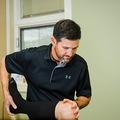
Our core refers to the center of our body as it functions to stabilize the trunk while the arms
and legs move. Its job is to spare our joints, particularly our spine, as well as transfer force away
from our torso. Proper function here can help us perform our best and prevent injury.
At the spinal level, functional stability is determined by three systems. Those systems include
active, passive, and neurological. Active stability is created by our muscles. Passive stability
comes from our ligaments as it contributes to our joint’s ability to handle different loads. Lastly,
the neurological component of stability is based on how we move. These components work
together to give us a strong and stable core.
There has been a strong movement away from traditional exercises that are utilized in the gym
to train spinal stability. Exercises such sit-ups and crunches can increase joint loads and, in
some cases, can be unsafe. They also do very little to teach us how to move.
Instead of these traditional exercises, functional movements that can enhance the active,
passive, and neurological components of stability have become a better option.
Having a stable core is important for preventing injuries and for enhancing performance in
sports and other activities. Don’t worry about training specific muscles, as they are all
important for spinal stability. Think instead about how the body moves and how to challenge
the torso from moving too much. Having a neutral spine throughout the exercises is critical to
executing them correctly and safely.
In this video, Dr. Donahue reviews a the bird-dog exercise, which a great exercises for
improving spinal stability and function.




